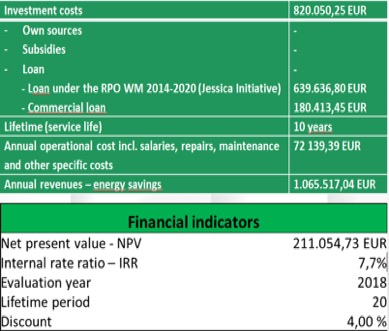Debt financing
Municipalities and regions, whose own funding resources are limited, obtain debt which is then paid back from the tax revenues of municipalities and saved energy costs and revenues generated by the projects themselves. Municipalities can obtain a loan from available public lending programs (municipal loans, for instance), a commercial loan from a commercial bank, or they can issue municipal bonds.
Among the advantages of debt-financing belongs access to capital which the municipality lacks for financing from own sources, possibility to combine the loan with other ways of financing, for example EU funding or revolving funds. On the other hand, the level of interest rate can considerably influence the profitability of the EE project implementation so this way of financing is suitable mainly for financially sustainable infrastructure projects of various sizes.
BOOSTEE-CE consortium mapped and documented 3 best practices on debt financing:
Reconstruction and extension of the tenement building in Płock , Poland
The overall investment costs were 820.000 EUR and the implemented measures included construction works - foundations of the ground floor, extensive electrical installations, sanitary installations, tele technical installation etc. The project was co-funded with the support of a commercial loan and the loan under 2014 – 2020 Jessica Initiative.
Best practice Factsheet #6 to this investment project is available on BOOSTEE-CE OnePlace platform, in the section Financing Energy Efficiency and involves comprehensive information on bank loans details, measures implemented, barriers encountered, success factors, etc.
Wood Cooperative Loški Potok: District heating with wood biomass in Hrib center, Slovenia
With the objective of the municipality of Loški Potok being energetically self-sufficient by 2015 and obtaining all the energy gained from renewable sources the particular activities this project is part of a wider concept including district heating with wood biomass (cooperative), exploitation of wind potential (cooperative) and public transport with electric vehicles.
The overall investment costs were 790.000 EUR and the project is co-funded with the support of a commercial loan.
The key results included 11 facilities connected to the district heating system. Since October 2017 the cooperative also manages the local post office 1318 Loški Potok, which would otherwise be closed.
The Wood Cooperative also successfully applied for a public tender for cutting wood in state forests for the period until the end of 2018.
Best practice Factsheet #4 to this investment project is available on BOOSTEE-CE OnePlace platform, in the section Financing Energy Efficiency and involves comprehensive information on bank loans details, measures implemented, barriers encountered, success factors, graphs of cash flow etc.
Modernization of the Heating System of Płońsk, combined generation of electricity and heat from biomass, Poland
The modernisation of Płońsk's heating system is an example of a model solution, the target of which is to decrease emissions of CO2, ash and other combustion gases into the atmosphere, and the production of clean electricity is compliant with the guidelines in the Polish National Energy Policy which promotes the production of energy from renewable resources.
The overall investment costs were 8.430.500 EUR and the project was co-funded with the support of the loan from National fund for environmental protection and water management. Best practice Factsheet #7 to this investment project is available on BOOSTEE-CE OnePlace platform, in the section Financing Energy Efficiency and involves comprehensive information on loans details, measures implemented, barriers encountered, success factors, financial indicators etc.






